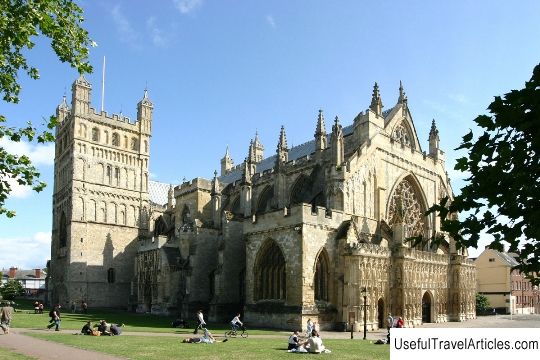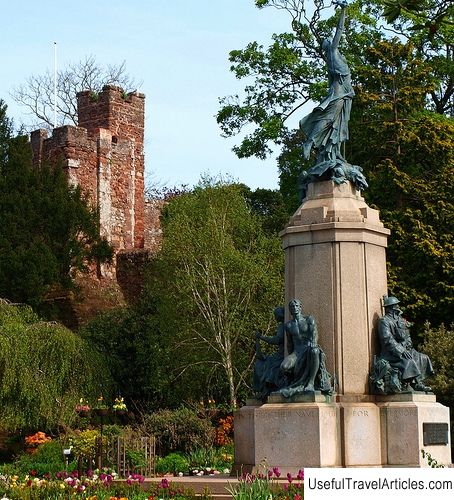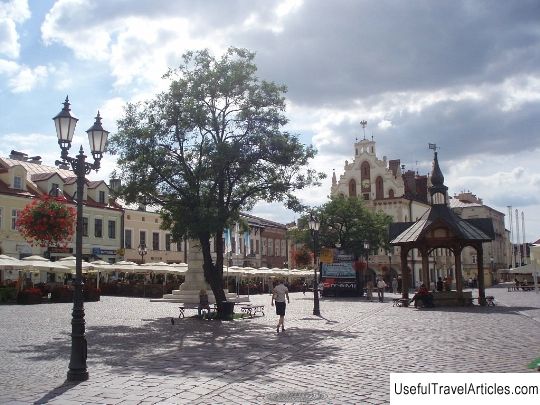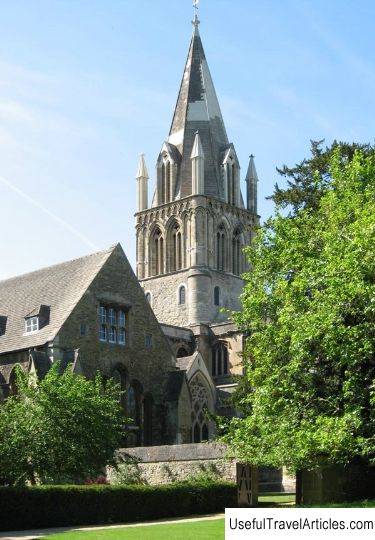Exeter Cathedral in Great Britain
Rating: 8,8/10 (2495 votes)  Exeter Cathedral (also known as the Cathedral of the Apostle Peter in Exeter) belongs to the Church of England and is located in Exeter, Devon in South West England. The Gothic cathedral has a number of features that make it unique in its kind.
Among such features are the first footrests for worshipers and misericords - ledges on which monks could sit to rest if the service was very long. The cathedral also has the longest vaulted ceiling in the country, since it is not interrupted by the central tower.
The extraordinary beauty of the stained-glass window of the Great East Window, as well as the unique Gallery of the Minstrels, depicting angels playing various musical instruments, attracts attention. It also contains the Exeter Book, the greatest and oldest collection of Anglo-Saxon poetry dating back to the 10th century. The huge astronomical clock, the creation of which dates back to the 15th century, is also considered a tourist attraction, however, the mechanism was completely replaced at the beginning of the 20th century.
The cathedral was founded in 1050, together with the transfer of the seat of the Bishop of Devon and Cornwall to Exeter. There was already a small Saxon church here, but it did not hold quite extensive divine services, so they often had to be moved outside.
The construction of a new large cathedral officially began in 1133, when William Varelwast, the nephew of William I the Conqueror, was appointed caretaker (for this reason, a building in the Norman spirit was built). However, already in 1258, only the recently completed building of the cathedral was considered out of date and began to be rebuilt by Bishop Walter Bronecombe in the Gothic style.
However, today you can see that Norman elements in the cathedral are preserved, for example, in the structure of the walls and two massive towers. The building materials were local stone and limestone. Most of the work was completed by 1400.
The campaign to close the monasteries and the English Revolution with its destruction of the cloisters deplorably affected the state of the building. However, later, under Charles II, the cathedral was somewhat restored and equipped with a new organ. The king's sister Henrietta Stuart was baptized here. Also, the cathedral has slightly updated its appearance in the Victorian era.
Exeter Cathedral suffered heavy damage during the bombing of the Second World War. On May 4, 1942, an air raid destroyed the chapel of St. James, and also damaged the side nave, a pair of pillars and the protective upper room. However, the main artifacts were hidden beforehand, so they did not suffer. Exeter Cathedral (also known as the Cathedral of the Apostle Peter in Exeter) belongs to the Church of England and is located in Exeter, Devon in South West England. The Gothic cathedral has a number of features that make it unique in its kind.
Among such features are the first footrests for worshipers and misericords - ledges on which monks could sit to rest if the service was very long. The cathedral also has the longest vaulted ceiling in the country, since it is not interrupted by the central tower.
The extraordinary beauty of the stained-glass window of the Great East Window, as well as the unique Gallery of the Minstrels, depicting angels playing various musical instruments, attracts attention. It also contains the Exeter Book, the greatest and oldest collection of Anglo-Saxon poetry dating back to the 10th century. The huge astronomical clock, the creation of which dates back to the 15th century, is also considered a tourist attraction, however, the mechanism was completely replaced at the beginning of the 20th century.
The cathedral was founded in 1050, together with the transfer of the seat of the Bishop of Devon and Cornwall to Exeter. There was already a small Saxon church here, but it did not hold quite extensive divine services, so they often had to be moved outside.
The construction of a new large cathedral officially began in 1133, when William Varelwast, the nephew of William I the Conqueror, was appointed caretaker (for this reason, a building in the Norman spirit was built). However, already in 1258, only the recently completed building of the cathedral was considered out of date and began to be rebuilt by Bishop Walter Bronecombe in the Gothic style.
However, today you can see that Norman elements in the cathedral are preserved, for example, in the structure of the walls and two massive towers. The building materials were local stone and limestone. Most of the work was completed by 1400.
The campaign to close the monasteries and the English Revolution with its destruction of the cloisters deplorably affected the state of the building. However, later, under Charles II, the cathedral was somewhat restored and equipped with a new organ. The king's sister Henrietta Stuart was baptized here. Also, the cathedral has slightly updated its appearance in the Victorian era.
Exeter Cathedral suffered heavy damage during the bombing of the Second World War. On May 4, 1942, an air raid destroyed the chapel of St. James, and also damaged the side nave, a pair of pillars and the protective upper room. However, the main artifacts were hidden beforehand, so they did not suffer.We also recommend reading Winchester Cathedral in the UK Topic: Exeter Cathedral in Great Britain. |




